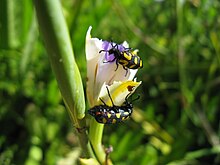Blister beetle
This article needs additional citations for verification. (November 2013) |
| Blister beetle Temporal range:
| |
|---|---|

| |
| Hycleus lugens | |
| Scientific classification | |
| Domain: | Eukaryota |
| Kingdom: | Animalia |
| Phylum: | Arthropoda |
| Class: | Insecta |
| Order: | Coleoptera |
| Infraorder: | Cucujiformia |
| Superfamily: | Tenebrionoidea |
| Family: | Meloidae Gyllenhaal, 1810 |
| Subfamilies | |

Blister beetles are beetles of the family Meloidae, so called for their defensive secretion of a blistering agent, cantharidin. About 7,500 species are known worldwide. Many are conspicuous and some are aposematically colored, announcing their toxicity to would-be predators.
Description[edit]

Blister beetles are hypermetamorphic, going through several larval stages, the first of which is typically a mobile triungulin. The larvae are insectivorous, mainly attacking bees, though a few feed on grasshopper eggs. While sometimes considered parasitoids, in general, the meloid larva apparently consumes the immature host along with its provisions, and can often survive on the provisions alone; thus it is not an obligatory parasitoid, but rather a facultative parasitoid, or simply a kleptoparasite. The adults sometimes feed on flowers and leaves of plants of such diverse families as the Amaranthaceae, Asteraceae, Fabaceae, and Solanaceae.[citation needed]
Cantharidin, a poisonous chemical that causes blistering of the skin, is secreted as a defensive agent. It is used medically to remove warts[1] and is collected for this purpose from species of the genera Mylabris and Lytta, especially Lytta vesicatoria, better known as "Spanish fly".
Toxicity[edit]
Cantharidin is the principal irritant in "Spanish fly", a folk medicine prepared from dried beetles in the family Meloidae.
The largest genus, Epicauta, contains many species toxic to horses. A few beetles consumed in a single feeding of alfalfa hay may be lethal.[2] In semiarid areas of the western United States, modern harvesting techniques may contribute to cantharidin content in harvested forage. The practice of hay conditioning, crushing the stalks to promote drying, also crushes any beetles present and causes the release of cantharidin into the fodder. Blister beetles are attracted to alfalfa and weeds during bloom. Reducing weeds and timing harvests before and after bloom are sound management practices. Using equipment without hay conditioners may reduce beetle mortality and allow them to escape before baling.[3]
Evolutionary history[edit]
The family is thought to have begun diversifying during the Early Cretaceous. The oldest fossil of the group is a larva (triangulin) found phoretic on a schizopterid bug from the mid Cretaceous Burmese amber, dated to around 99 million years ago.[4]
Systematics[edit]
Subfamily Eleticinae[edit]
Tribe Derideini
Tribe Morphozonitini
Tribe Eleticini
Tribe Spasticini
Subfamily Meloinae[edit]


Tribe Cerocomini
Tribe Epicautini
Tribe Eupomphini



Tribe Lyttini
- Acrolytta
- Afrolytta
- Alosimus
- Berberomeloe
- Cabalia
- Dictyolytta
- Eolydus
- Epispasta
- Lagorina
- Lydomorphus
- Lydulus
- Lydus
- Lytta
- Lyttolydulus
- Lyttonyx
- Megalytta
- Muzimes
- Oenas
- Parameloe
- Paroenas
- Physomeloe
- Prionotolytta
- Prolytta
- Pseudosybaris
- Sybaris
- Teratolytta
- Tetraolytta
- Trichomeloe
Tribe Meloini
Tribe Mylabrini

- Ceroctis
- Croscherichia
- Hycleus
- Lydoceras
- Mimesthes
- Mylabris
- Paractenodia
- Pseudabris
- Semenovilia
- Xanthabris
Tribe Pyrotini
- Bokermannia
- Brasiliota
- Denierota
- Glaphyrolytta
- Lyttamorpha
- Picnoseus
- Pseudopyrota
- Pyrota
- Wagneronota
Genera incertae sedis
Subfamily Nemognathinae[edit]


Tribe Horiini
Tribe Nemognathini
- Cochliophorus
- Euzonitis
- Gnathium
- Gnathonemula
- Leptopalpus
- Megatrachelus
- Nemognatha
- Palaestra
- Palaestrida
- Pseudozonitis
- Rhyphonemognatha
- Stenodera
- Zonitis
- Zonitodema
- Zonitolytta
- Zonitomorpha
- Zonitoschema
Tribe Sitarini
Genera incertae sedis
Subfamily Tetraonycinae[edit]
Tribe Tetraonycini
See also[edit]
References[edit]
- ^ Bhattacharjee, Pradip; Brodell, Robert T. (2003). "Cantharidin". In Robert T. Brodell; Sandra Marchese Johnson (eds.). Warts: Diagnosis and Management—an Evidence-Based Approach. London: Martin Dunitz. pp. 151–160. ISBN 1-84184-240-0.
- ^ University of Arizona VDL Blister Beetle Poisoning in Horses Archived July 24, 2008, at the Wayback Machine
- ^ University of Colorado Extension Blister Beetles in Forage Crops Archived 2015-01-10 at the Wayback Machine
- ^ Poinar, George; Brown, Alex (2014-10-02). "New genera and species of Jumping Ground Bugs (Hemiptera: Schizopteridae) in Dominican and Burmese amber, with a description of a meloid (Coleoptera: Meloidae) triungulin on a Burmese specimen". Annales de la Société entomologique de France. Nouvelle Série. 50 (3–4): 372–381. doi:10.1080/00379271.2014.982025. ISSN 0037-9271. S2CID 83047456.
External links[edit]
- Blister Beetle Intoxication: Cantharidin Poisoning
- meloidae.com
- blister beetles UF / IFAS Featured Creatures
- striped blister beetle, Epicauta vittata UF / IFAS Featured Creatures
- Beetle mania as 'extinct' insect found on Scots isle
- Ever so Strange: Blister Beetles
- Mylabris Pustulata Orange Blister Beetle found in Farms near Nagpur, Maharashtra, India
